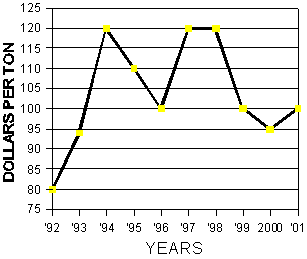Alfalfa Report
Yuma County, Arizona
February 12, 2001
Yuma County Office
2200 W. 28th Street, Ste. 102
Yuma, AZ 85364
(520) 726-3904
(520) 726-8472 FAX
Production Update:
PDF version, 14KB
Yield Losses: Substantial losses of yield occur in the normal haymaking process, usually on the order of 20 to 30%. Yield losses during harvesting result from incomplete recovery of hay in the windrow and from fragmentation or shattering of leaves and stems by the baler. Rain can shatter leaves and result in losses of dry matter. Yield can also be lost during storage from plant respiration and oxidation of the plant by microbes. Baled hay can lose 1% dry matter for each 1% moisture above 18%.
Insect Management: Egyptian alfalfa weevil, Hypera brunneipennis, are continuing to infest low desert alfalfa fields. Weevil larvae will begin to pupate toward the end of March. The numbers of weevil larvae will decline rapidly through April and newly emerged adults will be appearing in fields. Adult weevils do not cause economic damage, but do signal the end of Egyptian alfalfa weevil larval infestations for the year. In areas of higher elevation where frost may occur into April, the alfalfa weevil, Hypera postica, larvae may start appearing in alfalfa fields from mid-April through mid-June. The treatment threshold is the same for both species of alfalfa weevil, an average of 20 larvae per sweep. To sample for weevil larvae, divide the field in to 4 or more sections and take 5 sweeps in each section. To get the field average, divide the total number of weevil larvae by the total number of sweeps.
Weed Control: Proper identification is the first step in deciding
upon a control technique. If you are not sure what weeds you have, you
can drop them off at the extension office and we will try to identify
them. If we are not sure, we can send them to the University of Arizona
herbarium for identification. Sometimes, however, seedlings cannot be
properly identified and flowering plants are required. By then it is often
too late to start a control program.
| Market Summary |
High
|
Low
|
Average
|
Off grade
|
| Past 2 Weeks (Jan. 30 to Feb. 12, 2001) |
105
|
95
|
100
|
70-90
|
| Last Year (Jan. 30 to Feb. 12, 2000) |
105
|
90
|
95
|
65-80
|
10 Year Summary (January 30, to February 12, 1992-2001):

Issued in furtherance of Cooperative Extension work, acts of May 8 and June 30, 1914, in cooperation with the U.S. Department of Agriculture, James A. Christenson, Director Cooperative Extension, College of Agriculture and Life Sciences, The University of Arizona.
The University of Arizona is an equal opportunity, affirmative action institution. The University does not discriminate on the basis of race, color, religion, sex, national origin, age, disability, veteran status, or sexual orientation in its programs and activities.
Any products, services, or organizations that are
mentioned, shown, or indirectly implied in this web document do not imply
endorsement by The University of Arizona.
Information provided by:
Barry Tickes, btickes@ag.arizona.edu Extension Agent, Yuma County
Michael Ottman, mottman@ag.arizona.edu Agronomy Specialist
College of Agriculture, The University of Arizona.
Eric Natwick, etnatwick@ucdavis.edu UCCE Imperial County - Farm Advisor
University of California, Davis, CA.
Material written February 12, 2001.
Forages: Crop Mgmt | Soil Mgmt | Irrigation | Alfalfa Reports | Insects | Diseases | Weeds | Pesticides
Home | Other Crops | Forages
For more Arizona Production Ag Information:
Home | Cotton | Veggies| Forages | Grains | Citrus | Crop x Crop | Insects | Diseases| Weeds | Pesticides | News | Weather | Research | Photos | Contacts | General Info. | Site Map
Copyright © 2001 University of Arizona,
College of Agriculture and Life Sciences
Webmaster: Al Fournier (fournier@ag.arizona.edu)